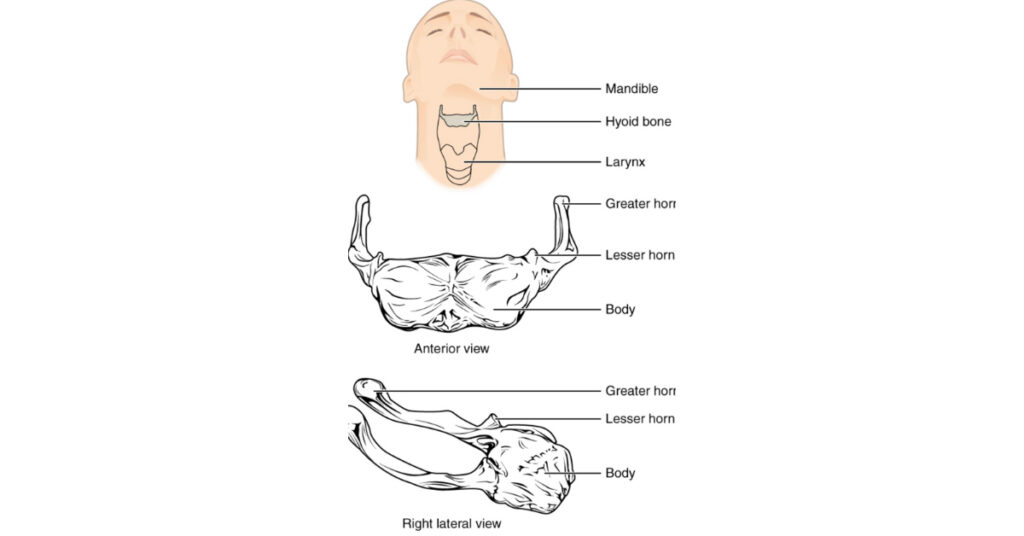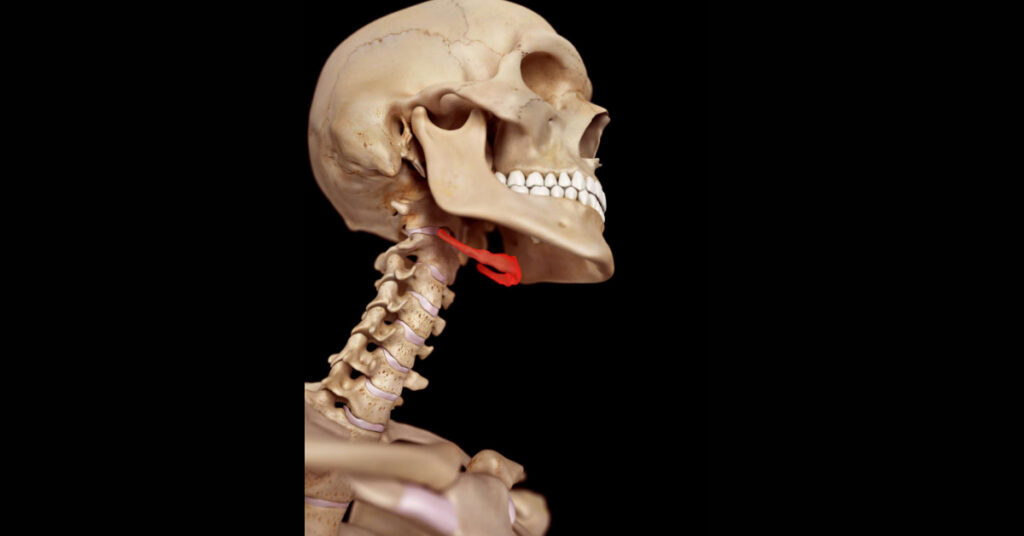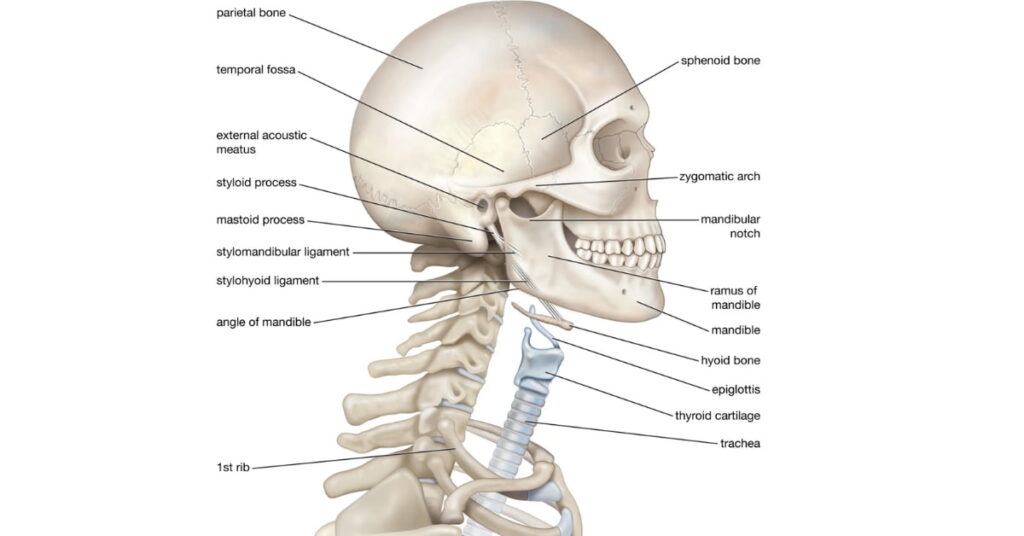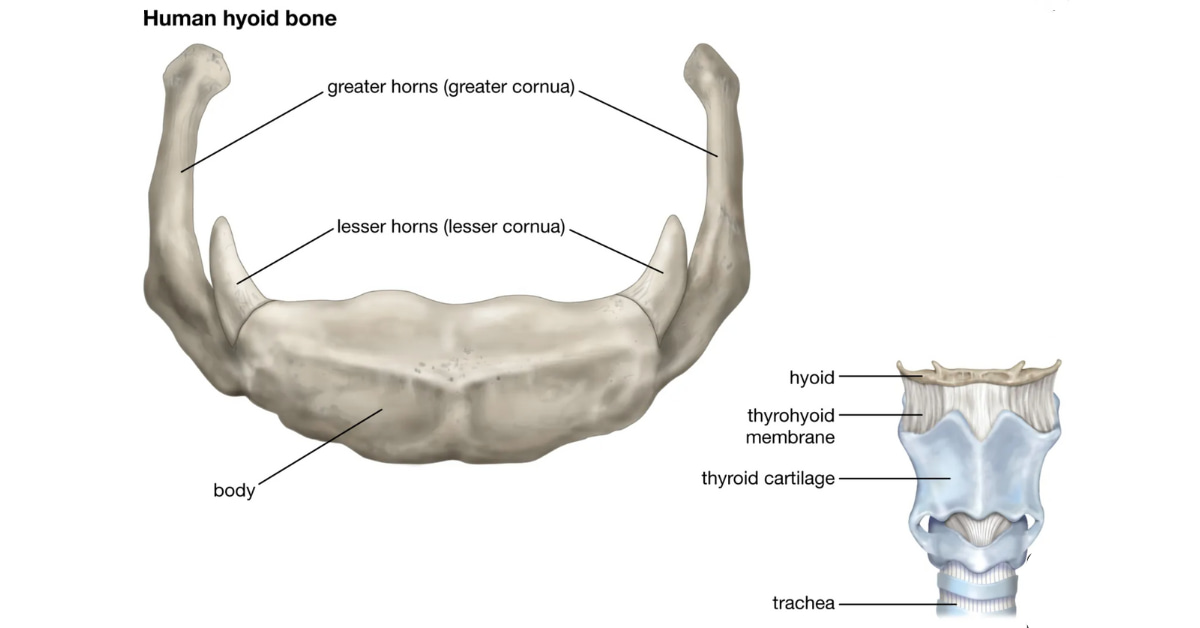Table of Contents
Introduction
The hyoid bone is a horseshoe-shaped structure located or discovered at the root of the tongue in the anterior neck between the lower jaw and the most prominent cartilage of the larynx – the thyroid cartilage.
The hyoid has no direct articulation with other bones; it is only connected distantly to other bones by muscles or ligaments. The hyoid is an attachment structure for the tongue and muscles on the oral cavity floor above, the larynx below, and the epiglottis and pharynx behind. It is hanged or suspended from the styloid functions of the temporal bones by the stylohyoid ligaments. It aids in tongue movement and deglutition.
Your bone is in the front of your neck. It supports the tongue and plays an important role in speaking & swallowing. Connected to near by structures via ligaments, muscles, and cartilage, it is your body’s only “floating” bone.
Hyoid bone
Your hyoid bone is a crescent-shaped bone at the front of your neck. It sits below your lower jaw (mandible) and above your thyroid cartilage (the protective tissue that covers your vocal cords). If you place your fingers where your chin and neck meet and then swallow, you can feel your hyoid bone.
The hyoid bone is unique because it’s your body’s only “floating” bone. That means it’s not connected to any other bone. Instead, it’s held in place by ligaments, muscles and cartilage.
Function
Your hyoid bone plays a key role in speaking, swallowing and breathing. It also provides support for several structures around it, like yours:
1.Tongue.
2. Muscles on the floor of your mouth.
3. Larynx (voice box).
4. Epiglottis.
5. Pharynx (throat).
Your hyoid bone is also an attachment point for three main ligaments and several muscles in your neck.
Structure
The hyoid bone is composed of a body, two more excellent horns & two lesser horns:
- Body – the central or major part of the bone. It has an anterior convex surface & a concave posterior surface.
- More excellent horn – projects from each end of the body in a superior, posterior, and lateral or sideways direction. It serves as a site of attachment for multiple neck muscles.
- The lesser horn – arises from the superior part of the bone, near the origin of the more fantastic horn. It launches superoposteriorly (toward the styloid function of the temporal bone). The stylohyoid ligament connects to the apex of the lesser horn.

Location
The hyoid bone is located or discovered in the front of the neck, below the lower jaw, and above the thyroid cartilage. It’s a small, U-shaped bone considered the body’s only “floating” bone because it’s not directly attached to other bones.
Location
- Front: The hyoid bone is located in the midline of the neck, in front of the lower jaw.
- Position: It is discovered just above the thyroid cartilage
- Back: It is found behind the fourth cervical vertebra.
- Shape: The bone is U-shaped or horseshoe-shaped. The outer border is convex, while the inner border is concave.
Anatomy
Where is the bone located?
Your bone sits at the front of your neck, below your lower jaw and above your thyroid cartilage. If you picture your spine, your bone “floats” in front of your 4th cervical (neck) vertebrae.
What does the hyoid bone look like?
Your bone is U-shaped and consists of three parts:
- Main body: Your hyoid bone’s front (and thickest) portion. The average bone body measures about 2.5 centimetres wide by 1 centimetre thick, though it tends to be slightly larger in males.
- More excellent horns (greater cornua): The two “arms” of your bone that make up the sides of the “U.”
- Lesser horns (lesser cornua): Two small bony protrusions near the origin of the more excellent horns where the stylohyoid ligament attaches.
At birth, a newborn’s hyoid bone consists of three separate bones. Those bones can fuse into one solid crescent-shaped structure during adulthood (usually between 40 and 60). But for some people, this fusion never takes place. Having an unfused bone doesn’t mean there’s something wrong, though. It’s just a variation of normal.
How can we take care of hyoid bone?
To take care of your hyoid bone, focus on practices that promote healthy swallowing mechanics and avoid direct trauma to the neck, including maintaining good posture, practising gentle throat exercises to improve muscle flexibility, avoiding forceful throat clearing, eating soft foods if necessary, and seeking medical awareness if you undergo significant pain or distress in the throat area; if you imagine a bone injury, consult a healthcare professional immediately as it may require specific therapy relying on the severity.
Key points about this bone care:
- Gentle exercises: Activities or exercises that target the muscles attached to the bone, like tongue stretches and jaw movements, can assist in keeping flexibility and proper positioning.
- Proper swallowing technique: Be aware of swallowing mechanics to bypass excessive strain on the bone.
- Posture awareness: Maintaining good posture helps to align the bone correctly.
- Dietary considerations: If you have a sensitive bone, eating soft foods can reduce strain during swallowing.
- Avoid forceful actions: Avoid sudden or excessive force on the neck, such as heavy lifting with improper form or forceful throat clearing.
When to see a doctor:
- Pain or discomfort in the throat: If you experience persistent pain, especially when swallowing, it could indicate a hyoid bone issue.
- Trauma to the neck: Seek immediate medical attention if you experience a significant neck injury.
- Difficulty swallowing: If swallowing becomes noticeably tricky, consult a healthcare professional.

Conditions and Disorders
What conditions or disorders affect your hyoid bone?
There are a few health conditions that can affect your bone, including:
- Hyoid bone syndrome. This condition occurs when inflammation in the muscles and ligaments surrounding your this bone. Causes may include tendonitis, whiplash or other injuries to the area.
- Broken hyoid bone. Fractures of the hyoid bone are rare, making up 0.002% of all broken human bones. Because the bone hides near the junction of your chin and neck, it rarely gets broken. Hyoid fractures most often result from strangulation. They can also result from hangings, gunshot wounds, car accidents and similar traumas.
- Osteoradionecrosis (ORN). It is a serious condition in which bone dies because of radiation exposure. People who receive head and neck radiation therapy have an increased risk. It’s most common in your lower jaw, but it can affect your this bone, too.
- Chondrosarcoma of the hyoid bone (a sporadic cancer). Chondrosarcomas are rare bone cancers that begin in your cartilage. It’s very uncommon to develop this type of cancer in your head and neck. Only 23 cases of bone chondrosarcoma are mentioned in medical literature. Among people with this condition, the most common symptom is a slow-growing lump on the neck.
Common symptoms of hyoid bone conditions
Conditions of the hyoid bone may share similar symptoms. Some of the most common include:
- Unexplained facial pain.
- Neck pain.
- Throat pain (chronic pharyngitis).
- Voice disorders.
- Feeling like there’s something stuck in your throat.
- Pain when swallowing.
- Obstructive sleep apnea.
- Bruising.
- A grating sound (crepitus).
- Difficulty speaking.
- Shortness of breath (dyspnea).
- Ulcers or Sores in the throat or mouth.
Symptoms of some hyoid bone conditions are similar to those of temporomandibular joint (TMJ) disorders. Because of this, some people get misdiagnosed. If you’ve received treatment for TMJ conditions but haven’t noticed any improvement, ask your healthcare provider if your this bone might be the culprit.
Hyoid bone Syndrome
The hyoid bone syndrome is a condition that causes pain & inflammation in the muscles and ligaments around the bone. It can be caused by tendonitis, whiplash, or other injuries.

how to fix dislocated hyoid bone
A dislocated bone can be treated with conservative or surgical methods. Conservative treatment involves rest, pain medication, and diet changes. If the dislocation creates breathing difficult, surgery may be required.
Conservative treatment
- Rest and observation
- Diet changes, such as eating soft or liquid foods
- Pain medication, such as ibuprofen
- Using a nasopharyngeal or oropharyngeal tube
- Antibiotic therapy
Surgical treatment
- Hyoid suspension: A surgeon or doctor makes a small incision in the upper neck, places screws in the jaw, & tightens a suture around the hyoid bone.
- Tracheotomy: A procedure to help keep the airway open
Hyoid bone dislocations can be caused by blunt trauma, strangulation, motor vehicle crashes, falls, assaults, and gunshot wounds.
Can you live without a hyoid bone?
Technically, you could still live without a bone, but it would significantly impact your ability to speak and swallow properly due to its crucial role in supporting the muscles involved in these functions; therefore, life without a bone would be significantly compromised.
Key points about the hyoid bone:
- Function: The bone is an anchor point for muscles used in swallowing and speaking, allowing for proper tongue movement and airway stability.
- Unique feature: It is the only bone in the human body that does not directly or straitly articulate with any other bone.
- Impact of removal: While part of the hyoid bone might be removed for specific surgical procedures, relying on or depending on the extent of the removal could lead to problems with speech and swallowing.
This is for informative objectives only. For medical guidance or diagnosis, consult a specialist.
Conclusion
The hyoid has no direct articulation with other bones; it is only connected distantly to other bones by muscles or ligaments. The hyoid is an attachment structure for the tongue and muscles on the oral cavity floor above, the larynx below, and the epiglottis and pharynx behind. It is hanged or suspended from the styloid functions of the temporal bones by the stylohyoid ligaments.




